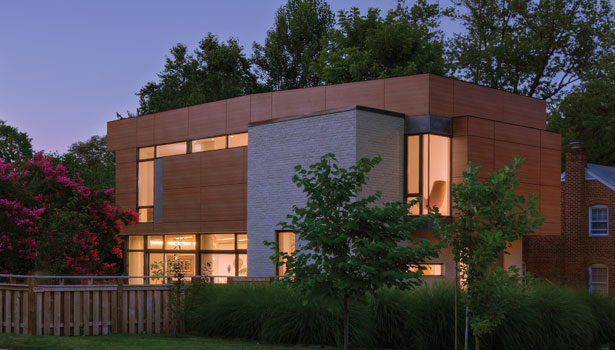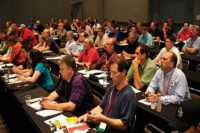Before renovation, the house at the corner of 27th and Edison Street in Arlington, Va., was a modest, two-story colonial, built in the post-war moment when houses were small and cars were large. Today, the house is a graceful composition of brick, glass and wood-accented rain screen known as +2edison7—Studio Twenty Seven Architecture’s playfully disjunctive name for this high-performing renovation with humble bones. Today, +2edison7 dwarfs its previous incarnation much in the way a 1950s land yacht might dwarf the current owner’s Miata. Yet, despite its added size, the renovated house performs like a Tesla.
As the personal home of one of the principals at Studio Twenty Seven Architecture, +2edison7 was a case study designed to push the envelope for efficiency in a residential project. The renovation more than doubled the volume of the original building, from 1,300 square feet to 2,800 square feet; yet its systems operate at more than 60 percent greater efficiency than before. The home has garnered multiple certifications, including USGBC’s LEED BD+C: Homes v3 Platinum and Home Innovation Research Labs (HIRL, formerly the NAHB Research Center) National Green Building Standard (NGBS) Gold Level. It is also certified as an EPA ENERGY STAR New Home, EPA Indoor airPLUS home, and locally at the Gold level in the Arlington County Green Home Choice award. Finally, the yard is a National Wildlife Federation Certified Wildlife Habitat. Indeed, +2edison7 may hold more sustainability accolades than any post-war tract home in the mid-Atlantic.
A classic example of rapidly deployed post-war construction, the original house was built with double-wythe masonry walls, wood frame floors and roof, and less-than-generous window openings arrayed in a neo-colonial composition. Capitalizing on close proximity to the brand new Pentagon, developers in the region built many of these small homes as quickly as possible. Housing policy of the day aimed to transform a nation of renters into a nation of owners and create a new economic engine, but efficiencies of scale did not equate to resource efficiency. Insulation was barely an afterthought, windows were single-paned, and there was no consideration of site, solar orientation or wind conditions. The tract homes of the post-war period, however modest, were gas-guzzlers out of sync with the ecology around them.
Rather than do a complete tear-down, Studio Twenty Seven Architecture wanted to retroactively harmonize this mid-century stereotype with its surroundings and rethink what standardization means today. The standard of choice is no longer a checklist of appliances and amenities but a checklist of performance criteria. While prototypical mid-century homes tended to perpetuate a ubiquitous aesthetic language that helped define a place and time, today’s standardization defies aesthetics and is concerned predominantly with effects. The renovation was a chance to employ the most stringent environmental standards of both LEED and NGBS and use them as a driver of form and aesthetics.
Despite substantially up-sizing the house, Studio Twenty Seven’s research led the firm to maintain the neighborhood scale as a reference point. The house massing builds from the scale of the original masonry core. An addition is slid atop in a manner that drops the dominant datum of the house and draws it down to the scale of its surroundings. The addition is then folded and shifted to open the house to the exterior and reorient the dominant fenestration so as to capitalize on daylighting. Taking into consideration private versus public views, the design team further refined the composition of windows and void. The result is a house that is open, capacious and airy from the inside, but discreet and slightly introverted from the exterior.
Site Orientation and Water Use
Re-harmonizing the house with its surroundings drove formal strategies. It also meant bringing the house down to earth—quite literally. Moving the ground floor from 2 feet in the air to grade allowed the design team to extend the main living spaces into the exterior. In good weather, with a wall of floor-to-ceiling windows open, the living room is one continuous space extending into the garden. With skylights illuminating the core, daylighting is maximized year-round, and cross-ventilation is strong enough to cool the entire house on mild days.
Approaches to water conservation contributed to formal strategies in both the building and site. A low-sloped roof collects rainwater, channeling it into an underground cistern in the front yard. The architects chose indigenous, drought-resistant plantings for the 100 percent porous site. Rainwater feeds the cistern water reserve from the site as well as the roof, via retaining wall and foundation drains.
Building Envelope Insulation and Sealing
Originally, the brick colonial had two above-grade levels with uninsulated walls and an unfinished basement. The renovated envelope was insulated with high-performance spray foam insulation, which both provides a good level of insulation and acts as a sealant. Coupled with the highest-performing thermally broken windows, the new envelope was almost hermetically air tight. With all doors and windows closed, practically all fresh air must be brought in through the mechanical ventilation system. The design team chose an energy-recovery ventilation (ERV) system. This system brings in outside fresh-air, passes it through a high particulate MERV 13 filtration system and exhausts the used interior air. During the air exchange, the ventilator captures up to 80 percent of the energy embodied in the temperature difference between the interior and exterior air, reducing the additional energy required to maintain the ideal temperature.
The design team also replaced the traditional gas boiler and forced-air cooling system with an all-electric geothermal—or ground-sourced—heat pump system. Using the consistent 55-degree temperature of the subterranean earth as both a heat source and a heat sink, the GSHP provides a baseline of warmth or cooling that is then supplemented before being distributed through the house. The bulk of +2edison7’s superior efficiency is derived from this system. Even with the house more than doubling in size, the average monthly energy bill decreased by 19 percent and the energy cost per square foot decreased by nearly two-thirds.
Before the renovation the house used gas and electricity. It now uses only electricity, so the gas and electric-use measurement has been combined and reported as British thermal units (Btu). Because the renovation significantly expanded the house, the amount of energy used before and after the renovation is reported on a per-square-foot basis as kBtu/sq. ft. These measurements allow for an even comparison of energy use before and after the renovation.
Other sustainable strategies further reduced resource consumption, including energy-efficient LED and CFL lighting, and ENERGY STAR appliances and ceiling fans. To minimize water use, dual-flush and low-flow toilets are used, and showers and faucets are equipped with low-flow aeration devices. Water usage for this single-family home has been cut in half. Additionally, the house’s original wood floors were salvaged, and supplemental flooring was provided by sustainably and regionally harvested forest providers associated with FSC. Countertops are recycled porcelain, glass and mirrors suspended within an epoxy resin. The exterior is a palette of durable, low-maintenance and high recycled content products such as integral color cement board and epoxy resin color panels. Reduced care requirements on products ultimately reduce continued chemical and manufacturing requirements, while also allowing the homeowners to spend more time in their garden.
Understanding the Design Impacts of Certification
Studio Twenty Seven chose to pursue multiple certifications in order to better understand how each form of certification impacts design decisions. At the time of project certification, USGBC required a minimum of 90 points for Platinum certification versus HIRL, which required a 697 point minimum for its highest certification level. Todd Ray, the Stuidio Twenty Seven design principal, sums it up this way, “USGBC establishes a performance-based system for its certification, attempting to take into account a whole-house approach to design.” In contrast, he says, “HIRL seems to have a more prescriptive approach, recommending best practices for the design and building industries.” This leads to an array of presumptive construction conditions about how credits should be given, and it offers a seemingly more straightforward, if static, checklist.
HIRL and its partners at the NAHB have worked with the International Code Council (ICC) to have the National Green Building Standard be the residential portion of the ICC’s green building code, now called ICC-700. At the same time, USGBC is taking LEED in a direction that better accounts for life-cycle impacts. USGBC is also moving in the direction where eventually all LEED-certified buildings will have to demonstrate (via utility usage and other building performance metrics) over time that each building is meeting LEED requirements in order to re-certify.
NGBS’s approach, by contrast, seeks to become the green baseline for all buildings by embracing a code model; but a code-based system of mandates does not foster innovation and change as life-cycle evaluations reveal decreases in performance. The performance-based approach championed by LEED fosters creative adaptation and integration of overall building systems, whereas the NGBS prescriptive approach considers buildings as a collection of individual components.
Locally, the Arlington County Community Energy & Sustainability Task Force has been instrumental in generating awareness of the resource-intense nature of the built environment. Buildings consume three-quarters of Arlington County’s energy. In the county 24 percent of all fuel use and 25 percent of greenhouse gas emissions come from residential buildings. Arlington aims to hold renovated residential buildings to a new standard. By 2015, residences that have undergone significant renovation will be expected to operate at least 30 percent more efficiently on average compared with 2007 performance.
Both the USGBC and the Arlington County Green Home Program have identified +2edison7 as an ideal case study for a sustainable renovation approach. As U.S. homeowners repurpose and redevelop their housing stock, it is vital they consider what it means to do this sustainably. Studio Twenty Seven’s case study home is an ideal example of how sustainability can help drive an award-winning design.
For more information, visit www.studio27arch.com.
+2edison7
Completion Date: 2011
Location: Arlington, Va.
Architect: Studio Twenty Seven Architecture
Green Rater: Everyday Green, Andrea Foss
Contractor: Phelps & Phelps Consulting
Structural Engineer: Ehlert/Bryan Inc.
MEP Engineers: Metropolitan Consulting Engineers, pllc
Certifications:
- USGBC LEED for Homes Platinum Level
- Home Innovation Research Labs National Green Building Standard Gold Level
- Arlington County Green Home Choice Gold Level
- EPA ENERGY STAR for New Homes
- EPA Indoor airPLUS
- National Wildlife Federation Certified Wildlife Habitat
Design Awards
- 2014 Remodeling Magazine Design Award
- 2013-2014 Arlington County Green Home Choice Case Study Home
- 2013 DESIGNArlington Award
- 2013 AIA DC Presidential Citation in Sustainable Design
Sustainable Products and Systems
Site:
- Sustainable Site
- Minimized site disturbed area
- Landscaping with native species plants
- Rainwater harvesting into a 1,700-gal. cistern to provide for garden irrigation
- Rear yard certified with National Wildlife Federation
Materials:
- Recycled and salvaged dumpster vs. landfill
- Low VOC (Volatile organic compounds) paints, adhesives and finishes
- Salvaged oak wood floor (from original house)
- FSC Certified oak hardwood floor
- Recycle content ceramic tile
- Composite wood + low urea-formaldehyde cabinets
- Salvaged brick
- Trespa - craft paper (recycled) and wood chip composite
- Exterior siding on rain-screen wall system on aluminum extrusions
- Icynene Open-Cell and Closed-Cell foam insulation
Systems:
- ENERGY STAR-certified appliances and ceiling fans
- Energy-efficient lighting (LED and compact fluorescent)
- Dual- and low-flow toilets
- Aerated low-flow faucets
- On-demand water flow system for structured plumbing (water recovery and optimizing hot water flow)
- Geothermal wells with Waterfurnace dual dampered zoned heating and cooling
- Programmable thermostat
- Energy recovery ventilation system (fresh air recovery)
- Passive ventilation systems
- Skylights and windows located for optimal daylight and heat gain
- Windows for primary views and cross ventilation
List of Educational outreach programs:
- Arlington Green Choice House Tours
- Arlington School Program House Tours
- Arlington County TV Earth Day Broadcast
- Arlington Magazine Green Home Feature
- Arlington County Swanson Elementary School Third Grade Class Tour
- Arlington County Green Home Choice Awards Ceremony
- Washington Post Sustainable Home Feature
- Green Building Institute 7–Class Series
- Clemson University School of Architecture Green Fundraising Event
- Maryland-National Capital Building Industry Association (MNCBIA) Seminar
- American Institute of Architects DC Chapter Design DC Seminar










